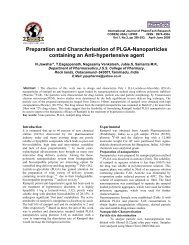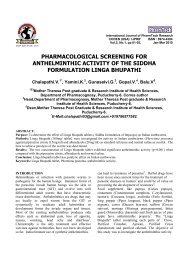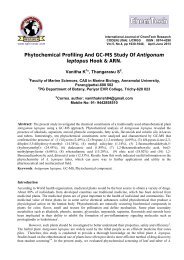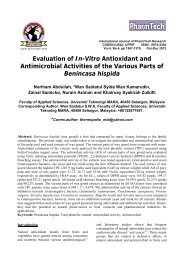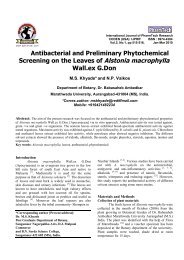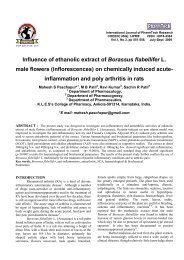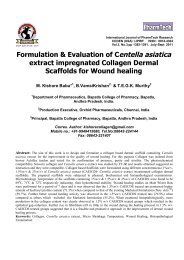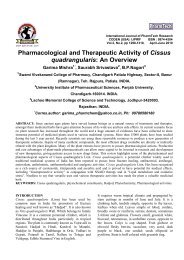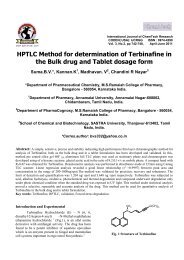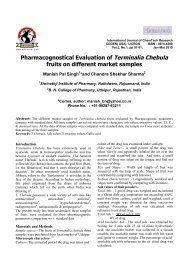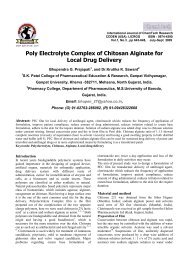Aliphatic and phenolic glycosides from the roots of Calotropis procera
Aliphatic and phenolic glycosides from the roots of Calotropis procera
Aliphatic and phenolic glycosides from the roots of Calotropis procera
You also want an ePaper? Increase the reach of your titles
YUMPU automatically turns print PDFs into web optimized ePapers that Google loves.
International Journal <strong>of</strong> PharmTech Research<br />
CODEN (USA): IJPRIF ISSN : 0974-4304<br />
Vol.4, No.1, pp 213-217, Jan-Mar 2012<br />
<strong>Aliphatic</strong> <strong>and</strong> <strong>phenolic</strong> <strong>glycosides</strong> <strong>from</strong> <strong>the</strong><br />
<strong>roots</strong> <strong>of</strong> <strong>Calotropis</strong> <strong>procera</strong> (Ait.) R.Br.<br />
Abhilasha Mittal 1 <strong>and</strong> Ali, M. 2 *<br />
1 Apex Institute <strong>of</strong> Pharmaceutical Sciences, V.T. Road, Mansarowar,<br />
Jaipur-302019, India<br />
2 Department <strong>of</strong> Pharmacognosy <strong>and</strong> Phytochemistry, Faculty <strong>of</strong> Pharmacy, Jamia<br />
Hamdard (Hamdard University), Hamdard Nagar, New Delhi-110062, India<br />
*Corres.author: maliphyto@gmail.com<br />
Abstract: An n-butanyl diglucuronoside <strong>and</strong> a <strong>phenolic</strong> glycoside characterized as n-butan-1,4-diol-1,4-β-Ddiglucuronopyranoside<br />
<strong>and</strong> O-methylresorcinyl-β-D-glucuronopyranosyl-(2®1)-β-D- glucopyranosyl-(2®1)-β-Dglucopyranoside,<br />
respectively, have been isolated for <strong>the</strong> first time <strong>from</strong> <strong>the</strong> methanolic extract <strong>of</strong> <strong>the</strong> <strong>roots</strong> <strong>of</strong><br />
<strong>Calotropis</strong> <strong>procera</strong> (Ait.) R. Br. (Asclepiadaceae) along with <strong>the</strong> known compounds α-amyrin acetate <strong>and</strong> βsitosterol<br />
glucoside. The structures <strong>of</strong> all <strong>the</strong> phytoconstituents have been established on <strong>the</strong> basis <strong>of</strong> spectral data<br />
analysis <strong>and</strong> chemical reactions.<br />
Keywords: <strong>Calotropis</strong> <strong>procera</strong>, Asclepiadaceae, Roots,butanediol diglucuronoside, methyl resorcinyl triglycoside.<br />
Introduction<br />
<strong>Calotropis</strong> <strong>procera</strong> (Ait) R. Br. (Asclepiadaceae) ,<br />
known as Apple <strong>of</strong> Sodom, Milkweed or Swallowwort,<br />
is a small, hardy, pubescent, evergreen, erect <strong>and</strong><br />
compact shrub, up to 4.5 m high, covered with cottony<br />
tomentum. It exudates copious milky sap when cut. It<br />
grows wild in south eastern Asia including India,<br />
Pakistan <strong>and</strong> Afghanistan, tropical Africa, Indochina,<br />
Morocco <strong>and</strong> Senegal mainly in drier <strong>and</strong> warm<br />
regions up to 1,050 m altitude on course, s<strong>and</strong>y <strong>and</strong><br />
alkaline soils. Its growth is luxuriant on rubbish heaps,<br />
waste or fallow l<strong>and</strong>s, along roadsides, sea shores <strong>and</strong><br />
river bank 1 . The root is cylindrical, branched, curved,<br />
light, woody <strong>and</strong> grayish white. It resembles with <strong>the</strong><br />
root <strong>of</strong> Cephaelis ipecacuanha (Broter) A. Richard<br />
(family Rubiaceae) in action <strong>and</strong> is substituted for it.<br />
The <strong>roots</strong> are alterative, an<strong>the</strong>lmintic, depurative,<br />
diaphoretic, emetic, expectorant, febrifuge <strong>and</strong><br />
purgative; used to treat anasarca, asthma, ascites,<br />
bronchitis, cough, cutaneous diseases, intestinal<br />
worms, leprosy <strong>and</strong> eczema 2,3 . The root powder<br />
promotes gastric secretion; fresh root is used as tooth<br />
brush to cure toothache 1 . A root paste mixed with <strong>the</strong><br />
leaves <strong>of</strong> Ocimum sanctum is taken orally to relieve<br />
menorrhoea 4 . Cardenolides 5,6 , flavone glycoside 7 ,<br />
pentacyclic triterpenoids 8-13 ; sterols 7,14 , fatty acids 5<br />
<strong>and</strong> norditerpenyl ester 13 have been reported <strong>from</strong> <strong>the</strong><br />
<strong>roots</strong>. This manuscript describes <strong>the</strong> isolation <strong>and</strong><br />
characterization <strong>of</strong> new aliphatic <strong>and</strong> <strong>phenolic</strong><br />
<strong>glycosides</strong> <strong>from</strong> <strong>the</strong> <strong>roots</strong> <strong>of</strong> C. <strong>procera</strong> collected <strong>from</strong><br />
<strong>the</strong> arid region <strong>of</strong> Rajasthan.<br />
Experimental<br />
Melting points were determined on a Perfit melting<br />
point apparatus (Ambala, India) <strong>and</strong> are uncorrected.<br />
IR spectra were recorded on KBr discs, using a Bio-<br />
Rad FT-IR 5000 spectrometer (FTS 135, Hongkong,<br />
China). UV spectra were measured with a Lambda Bio<br />
20 spectrophotometer (Perkin Elmer, Schwerzenbach,<br />
Switzerl<strong>and</strong>) in methanol. 1 H <strong>and</strong> 13 C NMR spectra<br />
were scanned using Bruker Advance DRY 400<br />
spectrospin <strong>and</strong> Bruker Advance DRY 100 spectrospin
Ali, M. et al /Int.J.PharmTech Res.2012,4(1) 214<br />
instruments (Germany), respectively, in DMSO-d6 <strong>and</strong><br />
TMS as an internal st<strong>and</strong>ard. FAB MS spectra were<br />
obtained using JEOL-JMS-DX 303 spectrometer<br />
(Bruker Daltonics, MA, USA). Column<br />
chromatography was performed on silica gel 60-120<br />
mesh. TLC was run on silica gel G (Qualigens,<br />
Mumbai, India). Spots were visualized by exposure to<br />
iodine vapours, UV radiation <strong>and</strong> by spraying reagents.<br />
Plant material: The <strong>roots</strong> <strong>of</strong> C. <strong>procera</strong> was<br />
collected <strong>from</strong> waste l<strong>and</strong> <strong>of</strong> Jaipur, Rajasthan, <strong>and</strong><br />
identified by Pr<strong>of</strong>. M. P. Sharma, taxonomist,<br />
Department <strong>of</strong> Botany, Faculty <strong>of</strong> Science, Jamia<br />
Hamdard, New Delhi. A voucher specimen (NO. PRL/<br />
JH / 08 / 32) is deposited in <strong>the</strong> herbarium <strong>of</strong> <strong>the</strong><br />
Faculty <strong>of</strong> Pharmacy, Jamia Hamdard, New Delhi.<br />
Extraction: The air-dried <strong>roots</strong> (2 kg) <strong>of</strong> C. <strong>procera</strong><br />
were coarsely powdered <strong>and</strong> extracted exhaustively<br />
with methanol in a Soxhlet apparatus for 72 hr. The<br />
methanolic extract was concentrated under reduced<br />
pressure to obtain dark brown viscous mass. Small<br />
portion <strong>of</strong> <strong>the</strong> extract was analyzed chemically to<br />
determine <strong>the</strong> presence <strong>of</strong> different chemical<br />
constituents. The viscous dark brown mass was<br />
adsorbed on silica gel (60-120 mesh) for column<br />
chromatography after being dissolved in little quality<br />
<strong>of</strong> methanol for preparation <strong>of</strong> slurry. The slurry (200<br />
g) was air dried <strong>and</strong> chromatographed over silica gel<br />
column packed in petroleum e<strong>the</strong>r. The column was<br />
eluted successively with petroleum e<strong>the</strong>r, mixture <strong>of</strong><br />
petroleum e<strong>the</strong>r <strong>and</strong> chlor<strong>of</strong>orm (9:1, 3:1, 1:1 <strong>and</strong> 1:3)<br />
finally with pure chlor<strong>of</strong>orm. Various fractions were<br />
collected separately <strong>and</strong> matched by TLC to check<br />
homogeneity. Similar fractions (having same Rf<br />
values) were combined <strong>and</strong> crystallized. The isolated<br />
compounds were purified by preparative TLC <strong>and</strong><br />
recrystallization.<br />
α-Amyrin acetate: Elution <strong>of</strong> <strong>the</strong> column with<br />
petroleum e<strong>the</strong>r - chlor<strong>of</strong>orm (1 : 9) afforded<br />
colourless crystals <strong>of</strong> α-amyrin acetate (1),<br />
recrystallized <strong>from</strong> acetone, 25 mg (0.022% yield), Rf<br />
: 0.6 (petroleum e<strong>the</strong>r-chlor<strong>of</strong>orm, 1:1); m.p.: 225-<br />
227 o C; IR nmax (KBr) : 1732, 1638 cm -1 ; 1 H NMR<br />
(CDCl 3 ) : d 5.12 (1H, m, H-12), 4.45 (1H, dd, J = 5.5,<br />
9.0 Hz, H-3α), 2.03 (3H, brs, COCH 3 ), 1.13 (3H, brs,<br />
Me-25), 1.06 (3H, brs, Me-23), 1.02 (3H, brs, Me-27),<br />
1.00 (3H, brs, Me-24), 0.97 (3H, d, J = 6.1 Hz,Me-30),<br />
0.94 (3H, d, J = 6.3 Hz, Me-29), 0.91 (3H, brs, Me-<br />
28), 0.86 (3H, brs, Me-26); 13 C NMR (CDCl3) : d<br />
80.43 (C-3), 123.82 (C-12), 139.08 (C-13), 170.43<br />
(Ac), 20.92 (COCH 3 ); +ve FAB MS m/z (rel. int.) :<br />
468 [M] + (C 32 H 52 O 2 ) (15.3).<br />
β-Sitosterol glucoside: Elution <strong>of</strong> <strong>the</strong> column with<br />
chlor<strong>of</strong>orm-methanol (19:1) furnished colourless<br />
amorphous powder <strong>of</strong> β-sitosterol glucoside (2),<br />
recrystallized <strong>from</strong> methanol, 260 mg (0.013% yield);<br />
m.p.: 270-272 º ; Rf: 0.53 (benzene: chlor<strong>of</strong>orm:<br />
methanol; 5:4:1). IRnmax (KBr): 3450, 2917, 2849,<br />
2383, 1636, 1460, 1074, 795 cm -1 ; +ve ESI MS m/z<br />
(rel. int.): 576 [M] + (C35 H60O6).<br />
Butanediol diglucuronoside: Elution <strong>of</strong> <strong>the</strong><br />
column with chlor<strong>of</strong>orm - methanol (4 : 1) gave<br />
colourless crystals <strong>of</strong> butanediol diglucuronoside (3),<br />
recrystallized <strong>from</strong> MeOH, 25 mg (0.022% yield), Rf<br />
: 0.8 (CHCl 3 -MeOH, 1:3), m.p. : 209 – 211 o C; UV<br />
lmax (MeOH) : 212 nm (log ε 3.2); IR nmax (KBr) :<br />
3425, 3388, 3255, 2924, 2854, 1680, 1610, 1404,<br />
1083, 1040 cm -1 . 1 H NMR (D 2 O) : d 5.08 (1H d,<br />
J=7.2 Hz H-1′), 4.90 (1H, d, J = 7.1 Hz, H-1"), 4.68<br />
(1H, d, J = 6.3 Hz, H=5'), 4.49 (1H, d, J = 8.1 Hz, H-<br />
5"), 4.22 (1H, m, H-2'), 4.19 (1H, m, H-2"), 4.01 (1H,<br />
m, H-3'), 4.92 (1H, m, H-3"), 3.72 (1H, m, H-4'), 3.64<br />
(1H, m, H-4"), 3.26 (2H, brs, H 2 -1), 3.15 (2H, brs,<br />
H 2 -4), 2.61 (2H, m, H 2 -2), 2.37 (2H, m, H 2 -3); 13 C<br />
NMR (D 2 O) : d 64.20 (C-1), 50.42 (C-2), 43.18 (C-<br />
3), 64.20 (C-4), 100.12 (C-1'), 74.11 (C-2'), 72.75 (C-<br />
3'), 71.41 (C-4'), 75.58 (C-5'), 181.94 (C-6'), 100.08<br />
(C-1"), 74.09 (C-2"), 72.72 (C-3"), 71.38 (C-4"),<br />
75.56 (C-5"), 179.77 (C-6"); +ve FAB MS m/z (rel.<br />
int.) : 442 [M] + (C 16 H 26 O 14 ) (11.3), 397 (38.2), 352<br />
(49.6), 334 (18.3), 193 (51.8), 177 (25.3), 149 (29.6),<br />
133 (35.0).<br />
Compound 3 (5 mg) was dissolved in ethanol (5<br />
ml), dil. HCl (2 ml) added <strong>and</strong> reaction mixture was<br />
heated for 1 hour on a steam bath. The solvent was<br />
concentrated under reduced pressure to get β-Dglucuronic<br />
acid, mp 164-165 o C, Rf 0.13 (phenol<br />
saturated with H 2 O).
Ali, M. et al /Int.J.PharmTech Res.2012,4(1) 215<br />
4"<br />
OH<br />
6"<br />
COOH<br />
OH<br />
O<br />
OH<br />
O CH 2 CH 2 CH 2 CH 2 O<br />
1"<br />
Methyl resorcinyl triglycoside: Elution <strong>of</strong> <strong>the</strong><br />
column with CHCl 3 - MeOH (3 : 2) furnished<br />
colourless crystals <strong>of</strong> methyl resorcinyl triglycoside<br />
(4), recrystallized <strong>from</strong> MeOH, 51 mg (0.044 %<br />
yield), Rf : 0.7 (CHCl3- MeOH, 13:7), m.p. : 160-161 o<br />
C; UV lmax (MeOH) : 212, 285 nm (log e 1.3, 0.7);<br />
IR nmax (KBr) : 3562, 3389, 3337, 3280, 2940, 2850,<br />
1690, 1460, 1366, 1210, 1003, 942 cm -1 ; 1 H NMR<br />
(DMSO-d6): δ 7.47 (1H, d, J=3.0 Hz, H-2), 6.57 (1H,<br />
m, H-4), 6.22 (1H, m, H-6), 5.59 (1H, m, H-5), 5.13<br />
(1H, d, J= 7.8 Hz, H-1'), 4.89 (2H, m, H-1'', H-1'''),<br />
4.75 (1H, m, H-5'), 4.69 (1H, m, H-5''), 4.46 (3H, brs,<br />
OMe), 4.31 (1H, m, H-5'''). 4.05 (1H, dd, J=7.8, 7.6<br />
Hz, H-2'), 4.02 (1H, m, H-2''), 3.00 (1H, m, H-2'''),<br />
3.87 (1H, m, H-3'), 3.70 (1H, m, H-3''), 3.64 (1H, m,<br />
H-3'''), 3.60 (1H, m, H-4'), 3.57 (1H, m, H-4''), 3.48<br />
(1H, m, H-4'''), 3.19 (1h, d, J=8.1 Hz, H2-6''a), 3.15<br />
(1H, d, J=8.1 Hz, H2-6''b), 3.04 (1H, d, J=9.0 Hz,<br />
H26'''a), 3.01 (1H, d, J=9.0 Hz, H2-6'''b); 13 C NMR<br />
(DMSO-d6): δ 162.30 (C-1), 151.81 (C-2), 164.15 (C-<br />
3), 124.71 (C-4), 122.06 (C-5), 140.13 (C-6), 108.87<br />
(C-1'), 75.25 (C-2'), 72.84 (C-3'), 71.91 (C-4'), 73.05<br />
(C-5'), 178.16 (C-6'), 96.94 (C-1''), 74.91 (C-2''),<br />
73.15 (C-3''), 70.35 (C-4''), 76.77 (C-5''), 61.24 (C-6''),<br />
92.27 (C-1'''), 72.65 (C-2'''), 72.84 (C-3'''), 70.62 (C-<br />
4'''), 72.38 (C-5'''), 61.22 (C-6'''), 56.02 (OMe); +ve<br />
ion ESI MS m/z (rel. int.) : 624 [M] + (C 25 H 36 O 18 )<br />
(2.1), 342 (2.6), 180 (100).<br />
Discussion<br />
Compound 1 <strong>and</strong> 2 were <strong>the</strong> known<br />
phytoconstituents characterized as α-amyrin acetate<br />
<strong>and</strong> β-sitosterol glucoside, respectively.<br />
Compound 3, named butanediol diglucuronoside,<br />
was obtained as a colourless crystalline mass <strong>from</strong><br />
chlor<strong>of</strong>orm – methanol (4 : 1) eluants. It gave<br />
effervescences with sodium bicarbonate solution<br />
indicating <strong>the</strong> presence <strong>of</strong> carboxylic group in <strong>the</strong><br />
4<br />
3<br />
1<br />
2<br />
1<br />
O<br />
6'<br />
COOH<br />
1' OH<br />
4'<br />
2'<br />
OH<br />
molecule. Its IR spectrum showed characteristic<br />
absorption b<strong>and</strong>s for hydroxyl groups (3425, 3388 cm- 1<br />
) <strong>and</strong> carboxylic function (3255, 1680 cm-1). On <strong>the</strong><br />
basis <strong>of</strong> FAB mass <strong>and</strong> 13<br />
NMR spectra, <strong>the</strong> molecular<br />
weight <strong>of</strong> 3 has been established at m/z 442<br />
corresponding to <strong>the</strong> molecular formula <strong>of</strong> an aliphatic<br />
diol diglycoside, C16H26O14 . It indicated four double<br />
bond equivalents, two each <strong>of</strong> <strong>the</strong>m were adjusted in<br />
<strong>the</strong> glycosidic units <strong>and</strong> carboxylic groups. The ion<br />
fragments arising at m/z 397 [M - COOH] + , 352 [397-<br />
COOH] + <strong>and</strong> 334 [352 - H2O] + supported <strong>the</strong><br />
presence <strong>of</strong> two carboxylic groups in <strong>the</strong> molecule.<br />
MeO<br />
4<br />
3<br />
2<br />
5 6<br />
1<br />
1'<br />
2<br />
O<br />
1"<br />
O<br />
O<br />
1"'<br />
O<br />
O<br />
6'<br />
COOH<br />
OH<br />
O<br />
6"<br />
OH<br />
4'<br />
OH<br />
OH<br />
6"'<br />
OH<br />
4"<br />
OH<br />
OH<br />
OH<br />
4"'<br />
OH<br />
The ion peaks generating at m/z 193 [C 5 H 8 O 5 -<br />
COOH] + , 149 [193-CO 2 ] +, 177 [C 5 H 8 O 4 - COOH] +<br />
<strong>and</strong> 133 [177 - CO 2 ] + suggested <strong>the</strong> existence <strong>of</strong><br />
glucuronic acid units in <strong>the</strong> molecule . The 1 H NMR<br />
spectrum <strong>of</strong> 3 exhibited two one-proton doublets at d<br />
5.08 (J=7.2 Hz) <strong>and</strong> 4.90 (J=7.1 Hz) assigned to
Ali, M. et al /Int.J.PharmTech Res.2012,4(1) 216<br />
anoneric H-1' <strong>and</strong> H-1" proton respectively. Two oneproton<br />
doublets at d 4.68 (J = 6.3Hz) <strong>and</strong> 4.49 (J = 8.1<br />
Hz) were ascribed to sugar H-5' <strong>and</strong> H-5",<br />
respectively. The o<strong>the</strong>r sugar protons appeared <strong>from</strong> d<br />
4.22 to 3.64. Two broad signals at d 3.26 <strong>and</strong> 3.15<br />
were attributed correspondingly to oxygenated<br />
methylene H 2 -1 <strong>and</strong> H 2 -4 protons. Two multiplets at d<br />
2.61 <strong>and</strong> 2.37 integrating for two protons each were<br />
associated with <strong>the</strong> methylene H 2 -2 <strong>and</strong> H 2 -3 protons<br />
respectively. The 13C NMR spectrum <strong>of</strong> 3 showed <strong>the</strong><br />
presence <strong>of</strong> sixteen carbon signals <strong>and</strong> <strong>the</strong> important<br />
for carboxylic carbons at 181.94 (C-6′) <strong>and</strong> 179.77 (C-<br />
6″), anomeric carbons at d 100.12 (C-1′) <strong>and</strong> 100.08<br />
(C-1") o<strong>the</strong>r sugar carbons <strong>from</strong> d 75.58 to 71.38,<br />
oxygenated methylene carbons at d 64.20 (C-1, C-2)<br />
<strong>and</strong> o<strong>the</strong>r methylene carbons at d 50.42 (C-2) <strong>and</strong><br />
43.18 (C-3). The absence <strong>of</strong> any singnal beyond d<br />
5.08 in <strong>the</strong> 1H NMR spectrum <strong>and</strong> between d 179.77<br />
to 100.12 in <strong>the</strong> 13<br />
C NMR spectrum supported <strong>the</strong><br />
saturated nature <strong>of</strong> <strong>the</strong> molecule. Acid hydrolysis <strong>of</strong> 3<br />
yielded β-D- glucuronic acid. On <strong>the</strong> basis <strong>of</strong> <strong>the</strong><br />
foregoing evidences, <strong>the</strong> structure <strong>of</strong> 3 has been<br />
characterized as n-butan-1,4-diol-1,4-β-D<br />
diglucuronopyranoside.<br />
Compound 4, named methyl resorcinyl<br />
triglycoside, was obtained <strong>from</strong> chlor<strong>of</strong>orm - methanol<br />
(3 : 2) eluants. It produced effervescences with sodium<br />
bicarbonate solution <strong>and</strong> gave positive tests for<br />
<strong>glycosides</strong>. Its IR spectrum showed characteristic<br />
absorption b<strong>and</strong>s for hydroxyl groups (3562, 3389,<br />
3337 cm-1 ) <strong>and</strong> carboxylic group (3280, 1690 cm-1). On <strong>the</strong> basis <strong>of</strong> 1H <strong>and</strong> 13C NMR spectra, <strong>the</strong><br />
molecular weight <strong>of</strong> 4 was established at m/z 624<br />
corresponding to <strong>the</strong> molecular formula <strong>of</strong> a <strong>phenolic</strong><br />
glycoside, C25H36O18 . The ion fragments arising at<br />
m/z 180 [C 6 H 12 O 6 ] + <strong>and</strong> 342 [C 6 H 11 O 5 -<br />
C 6 H 10 O 6 ] + indicated that diglucosidic unit was<br />
References<br />
1. Anonymous. The Wealth <strong>of</strong> India, Raw Materials,<br />
vol.3, New Delhi, Publication <strong>and</strong> Information <strong>of</strong><br />
Directorate, CSIR, 1992, p. 78-80.<br />
2. Warrier P.K., Nambiar V.P.K., Ramankutty C.<br />
Indian Medicinal Plants, vol. 1, Hyderabad,<br />
Andhra Pradesh, Orient Longman Ltd., 1994, p.<br />
431-345.<br />
3. Mhaskar K.S., Blatter E. , Caius J.F.m,. Kirtikar<br />
<strong>and</strong> Basu’s Illustrated Indian Medicinal Plants,<br />
attached to <strong>the</strong> terminal <strong>of</strong> <strong>the</strong> triglycoside unit. The<br />
1 H NMR spectrum <strong>of</strong> 4 exhibited a one-proton<br />
doublet at d 7.47 (J = 3.0) assigned to meta - coupled<br />
aromatic H-2 proton. Three one-proton multiplets at d<br />
6.57, 5.59 <strong>and</strong> 6.22 were ascribed to aromatic H-4, H-5<br />
<strong>and</strong> H-6 protons, respectively. A one-proton doublet at<br />
d 5.13 (J = 7.8 Hz) <strong>and</strong> a two - proton broad signal at d<br />
4.89 were attributed to anomeric H-1' <strong>and</strong> to H-1" <strong>and</strong><br />
H-1"' protons, respectively. The o<strong>the</strong>r sugar proton<br />
signals appeared <strong>from</strong> d 4.75 to 3.01. A three - proton<br />
broad signal at d 4.46 was accounted to methoxy<br />
proton. The 13 C NMR spectrum <strong>of</strong> 4 displayed carbon<br />
signals for 25 carbon atoms <strong>and</strong> <strong>the</strong> important signals<br />
appeared for carboxylic carbon at d 178.16 (C-6'),<br />
aromatic carbons in <strong>the</strong> range <strong>of</strong> d 164.15 - 122.06,<br />
methoxy carbon at d 56.02 anomeric, carbons at d<br />
109.87 (C-1'), 96.94 (C-1") <strong>and</strong> 92.27 (C-1"') <strong>and</strong><br />
hydroxymethylene carbons at d 61.24 (C-6") <strong>and</strong> 61.22<br />
(C-6'"). The o<strong>the</strong>r sugar carbons resonated <strong>from</strong> d<br />
76.77 to 70.35. The presence 1 H NMR signals <strong>of</strong> H-2'<br />
<strong>and</strong> H-2" as a one - proton double doublet at 4.05 (J =<br />
7.8, 7.6 Hz) <strong>and</strong> as a one-proton multiplet at d 4.02 <strong>and</strong><br />
13 C NMR signals for C-2' <strong>and</strong> C-2" at d 75.25, <strong>and</strong><br />
74.91 respectively, all in deshielded region, suggested<br />
(2®1) linkage <strong>of</strong> <strong>the</strong> sugar units. Acid hydrolysis <strong>of</strong> 4<br />
yielded glucuronic acid <strong>and</strong> D-glucose. On <strong>the</strong> basis <strong>of</strong><br />
spectral data analysis <strong>and</strong> chemical reactions, <strong>the</strong><br />
structure <strong>of</strong> 4 has been determined as O-methyl<br />
resorcinyl -β-D-glucuronopyranosyl (2®1)-β-Dglucopyranosyl-(2®1)-β-D-glucopyranoside.<br />
Acknowledgements<br />
The authors are thankful to <strong>the</strong> Head, SAIF, Central<br />
Drug Research Institute, Lucknow for recording<br />
spectral data <strong>of</strong> <strong>the</strong> compounds.<br />
Delhi, Sri Satguru Publication, 2000, p. 2217-<br />
2219.<br />
4. John A.P., Healing Plants <strong>of</strong> Peninsular India, UK,<br />
CABI Publication, Wallmgford, 2001, p. 125-126.<br />
5. Malik N.M., Chemical composition <strong>and</strong> active<br />
principles <strong>of</strong> <strong>Calotropis</strong> <strong>procera</strong>. Biochem. 1979;<br />
3: 97-101.<br />
6. Van Quaquebeke, E., Simon G., Andre A.,<br />
Dewelle J., El Yazidi M, Bruyneel F, Tuti J,<br />
Nacoulma O, Guissou P, Decaestecker C,<br />
Braekman JC, Kiss R, Darro, F. Identification <strong>of</strong> a<br />
novel cardenolide (2''-oxovoruscharin) <strong>from</strong>
Ali, M. et al /Int.J.PharmTech Res.2012,4(1) 217<br />
<strong>Calotropis</strong> <strong>procera</strong> <strong>and</strong> <strong>the</strong> hemisy<strong>the</strong>sis <strong>of</strong> novel<br />
derivatives displaying potent in vitro tolerance:<br />
structure-activity relationship analysis. J. Med.<br />
Chem. 2005, 48, 849-856.<br />
7. Lal S.D., Kumar P, Pannu D.S., Quercetin-3rutinoside<br />
<strong>from</strong> <strong>Calotropis</strong> <strong>procera</strong>. J. Sci Res.<br />
Bhopal. 1985, 7, 141-142.<br />
8. Gupta D.K., Ali M., Bhutani K.K., Triterpenoids<br />
<strong>from</strong> <strong>Calotropis</strong> <strong>procera</strong> root bark. Indian J.<br />
Chem. 1996, 35B, 1079-1083.<br />
9. Khan A.Q., Ahmed Z., Kazmi S.N.H., Malik A., A<br />
new pentacyclic triterpene <strong>from</strong> <strong>Calotropis</strong><br />
<strong>procera</strong>. J. Nat. Prod. 1988, 51, 925-928.<br />
10. Ansari S.H,. Ali M., Phytochemical <strong>and</strong><br />
Pharmacological Investigation <strong>of</strong> <strong>Calotropis</strong><br />
*****<br />
<strong>procera</strong> R.Br., Hamdard Medicus, 1999, 62, 96-<br />
101.<br />
11. Ansari S.H., Ali M., New Oleanene triterpenes<br />
<strong>from</strong> root bark <strong>of</strong> <strong>Calotropis</strong> <strong>procera</strong> (Ait) R. Br.,<br />
Indian J. Chem., 2000, 39 B, 287-290.<br />
12. Alam P., Ali M., Phytochemical Investigation <strong>of</strong><br />
<strong>Calotropis</strong> <strong>procera</strong> Ait. Roots. Indian J. Chem.<br />
2009,; 48, 443-446.<br />
13. Ansari S.H., Ali M.,. Norditerpenic ester <strong>and</strong><br />
pentacyclic triterpenoids <strong>from</strong> <strong>the</strong> root bark <strong>of</strong><br />
<strong>Calotropis</strong> <strong>procera</strong> (Ait.) R. Br. Pharmazie, 2001,<br />
56, 175-177.<br />
14. Khan AQ, Malik A. A new steroid <strong>from</strong><br />
<strong>Calotropis</strong> <strong>procera</strong>. Phytochemistry. 1989, 28,<br />
2859-2861.



